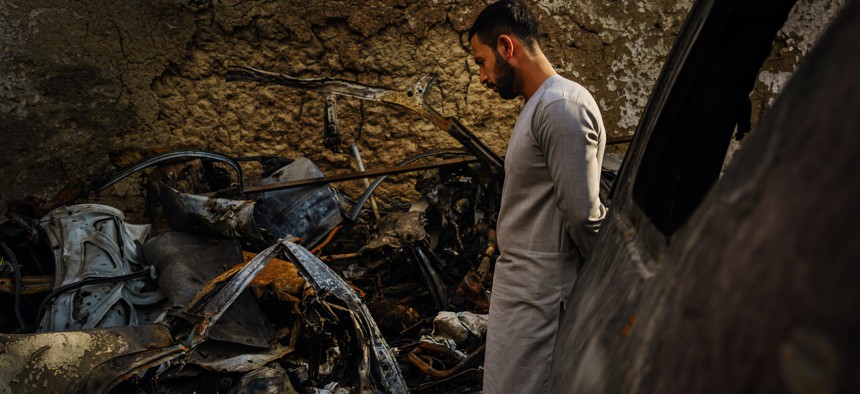
Emal Ahmadi surveys the damage to his family home in Kabul, Afghanistan, from a U.S. military drone strike that killed 10 of his family members, including his big brother, Zemari Ahmadi. Los Angeles Times / MARCUS YAM
After 20 Years of Civilian Drone Strike Deaths, Pentagon Creates An Office to Stop More
The military keeps repeating mistakes and is not ready for future fights because the lessons learned have not been instilled throughout the DOD, an independent review found.
Thousands of innocent civilians in Afghanistan, Iraq, and Syria have died from U.S. drone strikes in the past 20 years, and those casualties continue because past mistakes have not been acknowledged, reported, or shared among drone operators, an independent review by RAND found. That lack of institutional knowledge means that future conflicts involving drone strikes could be far deadlier.
On Thursday, Defense Secretary Lloyd Austin outlined guidance to establish a “civilian protection center of excellence” that would be the central point of collection for drone strike lessons learned and establish a uniform, central way for strikes to be reported and investigated, and victims compensated.
Two high-profile strikes—including the Aug. 29 strike in Kabul that killed a family of 10, and a 2019 strike in Baghuz, Syria, that killed as many as 70 civilians but was not acknowledged before it was detailed in a recent The New York Times’ investigation—elevated the department’s attention to the issue, Pentagon press secretary John Kirby said Thursday.
“Some of the thinking that's going into the ways the secretary wants to have a more structural implementation of changes is also quite frankly informed by some recent press reporting,” Kirby said.
For too long the department has eroded its credibility by not acknowledging the deaths, or by significantly undercounting them, said RAND senior researcher Mike McNerney.
“The way DOD engages external parties is often in a defensive sort of skeptical approach, doubting the allegations that come forward,” McNerney said. “That inconsistency creates problems from the perspective of the department's reputation, its reliability.”
For example, independent assessments of the number of civilian deaths in Syria in 2019 ranged from 490 to 1,118, RAND found—but the Pentagon’s official estimate was 21.
“When we looked at DOD civilian casualty estimates from conflicts, we found them to be far too low and damaging to the department's credibility,” McNerney said.
In the Thursday memo, Austin directed the under secretary of defense for policy, the comptroller, and other offices to report back within 90 days with a plan to reduce future civilian deaths and create a common approach among the services on how strikes will be investigated, reported, and compensated.
Because lessons from the past two decades of drone strikes have not been captured and shared across the services, the department is also ill-prepared to avoid drone strikes on civilians if conflict arises with Russia or China, McNerney said.
“The Pentagon is not ready for conflicts with potential adversaries like Russia or China,” McNerney said. “The scale of a conflict with a country like Russia or China or North Korea, the fact that some of that fighting would take place in urban environments with much more powerful munitions being used on both sides—it just means the risk of civilian casualties is much higher.”
A senior defense official who briefed reporters on the guidance said the department’s emphasis on civilian casualties was driven by previous deadly strikes, but was not meant to be a look back.
“Our main focus here is really looking at future conflicts. And if we're thinking about Syria, or Iraq, we're thinking about, I think, today's conflicts, if we're thinking about China or Russia. We're looking at this through the lens of more the strategic issues we're going to be dealing with in the future.”




